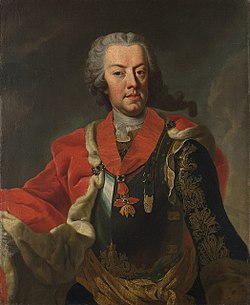History

There are many legends surrounding the origins of the march. Supposedly, the Bayreuth dragoon regiment, which was crucial in securing a Prussian victory, reported to its quarters the day after the battle while the march was played. Whether the march was actually played then is just as questionable as the claim that Frederick the Great was the composer of the piece. [3] It is understood that the king issued to the Bayreuther dragoon regiment a Gnadenbrief (letter of grace) that authorized it to play both grenadier marches of the foot soldiers (with flutes and drums) and the cuirassier marches of the cavalry (with kettledrums and trumpet fanfare).
The lyrics were certainly composed later; at the time of the victory of Hohenfriedberg, these Dragoons did not yet bear the title "Ansbach-Bayreuth".
The first outline (piano rendition) was written in 1795. For the first time in 1845, in celebration of the hundredth anniversary of the battle, the march was given lyrics, "Auf, Ansbach-Dragoner! Auf, Ansbach-Bayreuth!" because the regiment by then had been renamed "Ansbach-Bayreuth". In the time of the German Empire the title "Hohenfriedberger" was symbolic because of its connection with the great military victories of Frederick and the House of Hohenzollern.
In commemoration of the victories of Frederick against the Austrians, Johann Gottfried Piefke added "Der Hohenfriedberger" as a trio to his "Königgrätzer Marsch" written after the victorious Battle of Königgrätz in 1866. [4]



